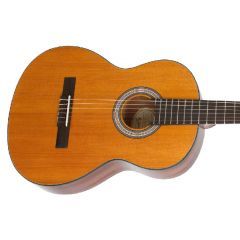-
Sale
 Epiphone Classical E1 - 1.75" Nut - Acoustic Guitar - Antique Naturalcode: EAPCANCH1Special Price £99.00 Regular Price £129.00
Epiphone Classical E1 - 1.75" Nut - Acoustic Guitar - Antique Naturalcode: EAPCANCH1Special Price £99.00 Regular Price £129.00
More
Classical guitars share many similar characteristics to standard modern acoustics, but their differences are significant. As the name suggests, they are designed to be played in the classical style, that is, in a seated position, supported by the left leg, and for the most part, employing a fingerpicking technique. This style of playing has a direct impact on the structure of the guitar and the materials used to build it.
The fingerpicking technique is well served by nylon strings, so the structure of a classical guitar is built to suit. Nylon strings (and sometimes nylon wound with metal) require less tension than steel strings, and so the neck of a classical guitar can be solid wood without the need for a truss rod. The body also requires less bracing, so the guitar can be lighter and create a different tone, while the neck is commonly wider with a flat fingerboard. Smaller aesthetic differences can often be seen too, such as the lack of markers on the face of the fretboard and reverse mounted machine heads.
Classical guitars are brilliant for beginners due to their wider-spaced nylon strings. These make it easier for hands that are unaccustomed to holding chord shapes and fingers that aren't yet tough enough for steel strings. In summary, if you are a beginner or looking for a guitar to support the classical style or similar, these would be the best options for you. If, however, you are looking for a more modern, all-round performer, a steel-string acoustic might be the way to go.




